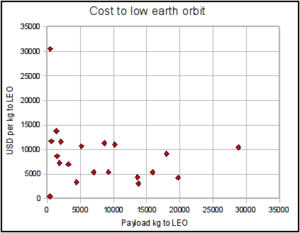Difference between revisions of "Financial effort estimation"
(rv) |
|||
| Line 71: | Line 71: | ||
*[http://www-personal.umich.edu/~chadjo/talks/LaunchSystems.ppt Michigan Mars Society - Launch Systems: Today and Tomorrow] | *[http://www-personal.umich.edu/~chadjo/talks/LaunchSystems.ppt Michigan Mars Society - Launch Systems: Today and Tomorrow] | ||
| − | [[Category: | + | [[Category: Commerce and Economics]] |
| − | |||
==References== | ==References== | ||
<references/> | <references/> | ||
Revision as of 22:56, 17 December 2018
This page is a collection of Financial effort estimations. It covers all planning, preperations, material, transport, administration, etc. Funding is needed to make the colonization possible.
Contents
Systematics
There are several stages that can be calculated separately:
- Transportation from Earth to Earth's orbit
- Transportation from Earth's orbit to Mars' orbit
- Transportation from Earth's orbit to Mars' surface
- Transportation from Earth's orbit to Earth's moon
- Transportation from Earth's moon to Mars' orbit
- Transportation from Earth's moon to Mars' surface
Cost per kg from Earth to Low earth orbit (unmanned)
Small launch vehicles (less than 2300kg): [1]
- USA, Athena 2 (2065kg to LEO): $11622 per kg
- Russia, Cosmos (1500kg to LEO): $8667 per kg
- USA, Pegasus XL (443kg to LEO): $30474 per kg
- Russia, Rockot (1850kg to LEO): $7297 per kg
- Russia, Shtil (430kg to LEO): $465 per kg
- Russia, START (632kg to LEO): $11687 per kg
- USA, Taurus (1380kg to LEO) $13768 per kg
- USA, Falcon 1e (430 to LEO) $1010 per kg
Medium launch vehicles (less than 12000kg):
- Europe, Ariane 44L (10200kg to LEO): $11029 per kg (last launch 2003)
- USA, Atlas 2AS (8618kg to LEO): $11314 per kg
- USA, Delta 2 (5144kg to LEO): $10692 per kg
- Russia, Dnepr (4400kg to LEO): $3409 per kg
- China, Long March 2C (3200kg to LEO): $7031 per kg
- China, Long March 2E (9200kg to LEO): $5435 per kg
- Russia, Soyuz (7000kg to LEO): $5357 per kg
- USA, Falcon 9 (10450Kg to LEO) $4775 per kg first launch 2010
Heavy launch vehicles (more than 12000kg):
- Europe, Ariane 5G(18000kg to LEO): $9167 per kg
- China, Long March 3B(13600kg to LEO): $4412 per kg
- Russia, Proton(19760kg to LEO): $4302 per kg
- USA, Space Shuttle(28803kg to LEO): $10416 per kg ( lasts launchs 2011-2012)
- Ukraine, Zenit 2(13740kg to LEO): $3093 per kg
- Multinational, Zenit 3SL(15876kg to LEO: $5354 per kg
- USA, Falcon 9 Heavy (32000Kg to LEO) $2968 per kg (still in developement )
super heavy ( saturn V class )
- USA, SLS ( after space shuttle withdrawal) (70 000Kg to 130 0000Kg to LEO) work in progress
Cost per person from Earth to Earth's orbit
Here the mass of the person with an average of 70 kg is only part of it. Additional mass is calculated for the life support systems. Rockets must be man-rated for them to be used in manned transportation to space.
Current:
- USA, Space Shuttle: A partially re-usable manned transportation system. Cost estimates range from $100 million to $1 billion per launch.
- Russia, Soyuz-TMA :A robust module in its fifth generation of Soyuz-spacecraft. Cheaper than the Space Shuttle.
- China, Shenzou: The Chinese manned spacecraft, 3 manned flights have been launched.
Planned:
- USA, SpaceX Dragon: An upcoming manned spacecraft, the first by a private corporation. Might enable cheap manned access to orbit by the SpaceX rockets using the Falcon9 rocket. Cost: $49.9 million, plus a Dragon module (cost unknown atm).
- USA, Orion spacecraft: Will be using the new Ares I rocket, and will replace the Space Shuttle.
the ares 1 and ares V programm are canceled the new SLS launcher in devellopement ( 70 000KG to 130 000KG to earth's orbit ) will be use for Orion spacecraft
- USA, SpaceShipThree: A possible orbital spaceplane by Scaled Composites.
Cost estimations in existing publications
- NewScientist 2004: "A human mission to Mars is expected to cost $40 billion to $80 billion."
- MARS DAILY 2007: "U.S. experts estimate the cost of a manned mission to Mars at $500 billion. Russia believes it can place cosmonauts on the planet's surface in the next 12 years for just $14 billion, ..."
- Mars direct was estimated by NASA to be $55 billion
- Mars One is planned to cost "six billion US dollars".
These huge differences are the result of different mission targets - simple mission of flying to Mars and back (plans by Roskosmos (Russia) - similar to lunar Apollo program) is far more cheaper than permanent setlement or even NASA expediture mission (staying 90 days or about year). Expensivness of current NASA mission plans mostly comes from the fact, that they includes LEO, Moon base stages with 3+ subsequential flies to Mars, with manned ~600 day stay.







